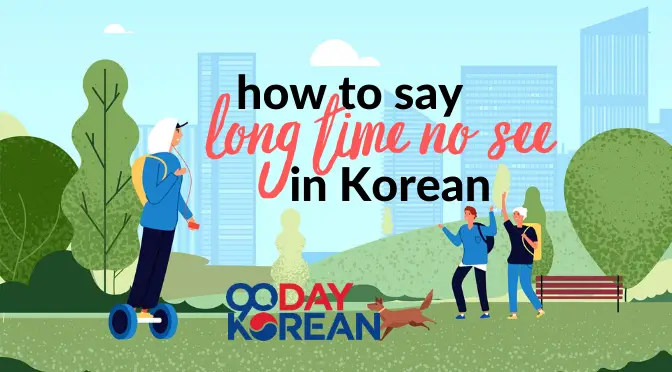In this article, we will teach you how to say “long time no see” in Korean.
Whether you’re currently learning Korean or just want to know more about what’s being said in your favorite Korean drama, this phrase is guaranteed to come in handy.
Let’s see what this friendly phrase is all about!
Contents
Ways to say “Long time no see” in Korean
The phrase for “long time no see” in Korean is only used in informal and standard Korean speech and is most commonly used among acquaintances and friends. The base vocabulary for the phrase is 오랜만 (oraenman), which translates to “long time.”
오랜만 (oraenman)
long time
You’ll simply attach it to the verb ending of the correct level of politeness to form the phrase “long time no see.” Below are the different ways to say “long time no see” in Korean.
We’ve also laid out a few example sentences, both standard and informal, that you can begin practicing with immediately.
“Long time no see” in Korean (Standard)
The standard way to say “Long time no see” in Korean is 오랜만이에요 (oraenmanieyo).
This is normally used when talking to people of a similar age or someone who you are not really close with. The examples below can be used in any situation that doesn’t require you to be exceptionally polite or formal.
Sample sentences:
오랜만이에요! 그동안 잘지냈어요? (oraenmanieyo! geudongan jaljinaesseoyo?)
Long time no see! Have you been well?
태영 씨, 오랜만이에요. (taeyeong sshi, oraenmanieyo.)
Ms. Taeyong, long time no see.
“Long time no see” in Korean (Informal)
If you’d like to say this phrase informally, you can say 오랜만이야 (oraenmaniya) instead. You can use these examples and informal speech with your family, friends, and those who are close to you.
Sample sentences:
남동생이랑 같이 밥을 먹는거 진짜 오랜만이야! (namdongsaengirang gati babeul meogneungeo jinjja oraenmaniya!)
It has been a really long time since I last had a meal together with my little brother.
오랜만이야! 잘지냈지? (oraenmaniya! jaljinaetji?)
Long time no see! You’ve been well, right?
Other ways to say “long time” in Korean
You can also use the Korean word 오랜만 (oraenman) with different conjugations to illustrate similar phrases. For example:
오랜만에 (oraenmane)
in a long time; after a long time
Sample sentence:
오랜만에 출근을 해서 긴장되고 있어요. (oraenmane chulgeuneul haeseo ginjangdoego isseoyo.)
Since I’m going to work for the first time in a long time, I’m feeling nervous.
How to use “Long time no see” in Korean in sentences
Now that know the Korean way to say “long time no see” or “it’s been a while,” you may also want to further familiarize yourself with this phrase through this video. This will teach you additional sentences and how to pronounce each word correctly.
A word of caution about Romanization
While it is possible for you to study the words in this article simply by reading their romanized versions, it will come in handy for you to be able to read Hangeul if you ever wish to come to Korea. Hangeul is the Korean alphabet, and not difficult to learn. In fact, you can learn it in under 60 minutes.
After you’re familiar with Hangeul, life in Korea will suddenly seem so much easier, and the country won’t appear as foreign to you. So, if you’re serious about learning Korean, why not learn Hangeul today?
Check out this article to learn more ways to greet friends who you haven’t met for a long time. If you’d like to express how long it has been exactly since you’ve last seen someone, you can also learn how to tell the time in Korean!
Do you already know who you’ll want to practice your newly learned Korean phrase “long time no see” with first? Show us your sample sentence in the comments below!
Picture Credit: Bigstock






How do you respond to your friend if they said ‘long time no see’?
You can say something like ‘오랜만이야. 잘 지냈어? (Long time no see. How have you been?)’
What is the Instagram address for 90 Day Korean?
Hi, Jack! It’s Instagram.com@90daykorean. Thanks for your support! ^^